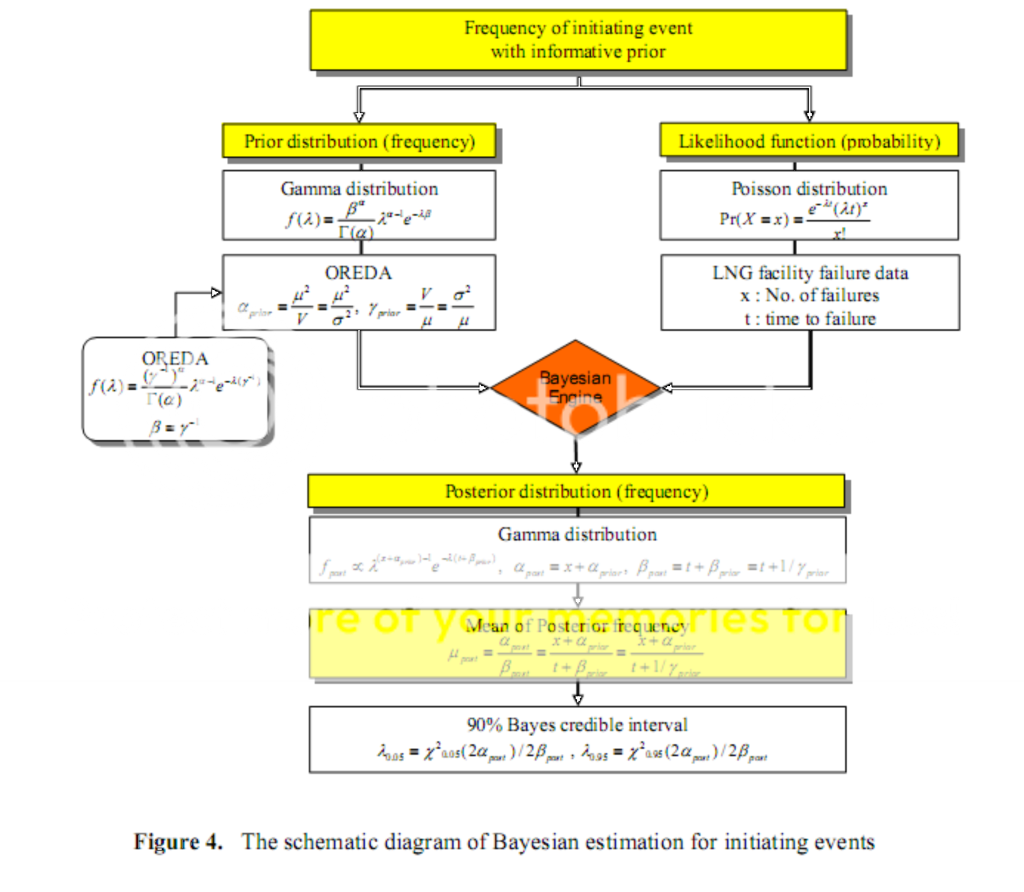In order to meet the fast growing LNG (Liquefied Natural Gas) demand, many LNG importation terminals are operating currently. Thus, it is important to estimate the potential risks in LNG terminals with LOPA (Layer of Protection Analysis) which can provide quantified results with less time and efforts than other methods. For LOPA application, failure data are essential to compute risk frequencies. However, the failure data from the LNG industry are very sparse and have statistically shake grounds. Therefore, Bayesian estimation, which can update the generic data with plant specific data, was used to compensate for its weaknesses.
Based on Bayesian estimation, the frequencies of initiating events were obtained using a conjugate gamma prior distribution such as OREDA (Offshore Reliability Data) and Poisson likelihood distribution. If there is no prior information, Jeffreys noninformative prior may be used. The LNG plant failure database was used as plant specific information. The PFDs (Probability of Failure on Demand) of IPLs (Independent Protection Layers) were estimated with the conjugate beta prior such as EIReDA (European Industry Reliability Data Bank) and binomial distribution. In some cases, EIReDA did not provide failure data, so the newly developed Frequency-PFD conversion method was used instead. By the combination of Bayesian estimation and LOPA procedures, the Bayesian-LOPA methodology was developed and was applied to an LNG terminal. The found risk values were compared to the tolerable risk criteria to make risk decisions and compared to each other to make a risk ranking. The Bayesian-LOPA methodology can be used in other industries. Furthermore, it can be used with other frequency assessment methods such as Fault Tree Analysis (FTA) and Event Tree Analysis (ETA) to strengthen their results.
LNG (Liquefied Natural Gas) is one of the fastest growing energy sources in the U.S. to fulfill the increasing energy demands and diversify the energy portfolio. In order to meet the LNG demand, many LNG facilities including LNG importation terminals are operating currently. Moreover, there are many proposed projects for LNG terminals to fill the gap between supply and demand of LNG in North America. Therefore, it is important to control and estimate the potential risks in LNG terminals to ensure their safety and reliability.
Figure 1. Description of an LNG importation terminal (www.kogas.co.kr)
One of the most cost effective ways to estimate the risk is LOPA (Layer of Protection Analysis) because it can provide quantified risk results with less time and efforts than other methods. Thus, LOPA was applied in this research. For LOPA application, failure data are essential to compute risk frequencies (see Figure 2). However, the failure data from the industry are very sparse and have statistically shaky grounds due to insufficient population of sample data and relatively short-term operational history. Bayesian estimation is identified as one of the better methods to use to compensate for the weaknesses found in the LNG industry’s failure data. It can update the generic data with plant specific data. In other words, the data updated by Bayesian logic can reflect both long-term based historical experiences and plant specific conditions. Thus, in this research, the new Bayesian-LOPA methodology was developed as shown in Figure 3, and it was applied to an LNG importation terminal to estimate the potential risks.
Based on Bayesian estimation, the frequencies of initiating events were obtained using a conjugate gamma distribution as the prior information and Poisson distribution as the likelihood function. OREDA (Offshore Reliability Data) database was used as a prior distribution because it was produced from a gamma distribution (see Figure 4). If there is no prior information, Jeffreys noninformative prior may be used. The LNG plant failure database was used as plant specific likelihood information. The PFDs (Probability of Failure on Demand) of IPLs (Independent Protection Layers) were estimated with the conjugate beta prior distribution and binomial likelihood distribution. EIReDA (European Industry Reliability Data Bank) database was used as prior information because it provided the failure data made from beta distribution. In some cases EIReDA did not provide failure data, so the newly developed Frequency-PFD conversion method was used instead. By the combination of Bayesian estimation and LOPA procedures, the Bayesian-LOPA methodology was developed. The method was applied to an LNG importation terminal. For seven incident scenarios, it produced valid risk values. The posterior values of every initiating event or IPLs are located between prior and likelihood values. This means that the posterior values are valid and well-updated. The found risk values were compared to the tolerable risk criteria given by CCPS (Center for the Chemical Process Safety) to make risk decisions. Finally, the estimated risk values of seven incident scenarios were compared to each other to make a risk ranking in view of probabilistic risk analysis which considers only failure frequency without considering consequence analysis. In conclusion, as the good safety records of LNG industries speak, in this research, it can be generally concluded that the LNG terminal has good safety protections to prevent dangerous events (see Figure 5). The newly developed Bayesian-LOPA methodology as one of the risk assessment methods really does work well in an LNG importation terminal and it can be applied in other industries including refineries, petrochemicals, nuclear plants, and aerospace industries. Moreover, it can be used with other frequency analysis methods such as Fault Tree Analysis (FTA) and Event Tree Analysis (ETA).
Figure 3. The flow diagram of this research
Special Thanks to :
Geun Woong Yun
from Texas A&M University










0 comments:
Post a Comment